
Broadmeadows railway station is located on the Craigieburn line in Victoria, Australia. It serves the northern Melbourne suburb of Broadmeadows, and opened on 1 February 1873.
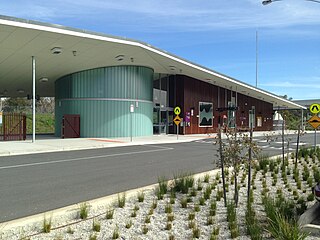
Wodonga railway station is located on the North East line in Victoria, Australia. It serves the city of Wodonga, and it opened on 25 June 2011.
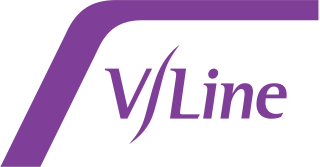
V/Line is a statutory authority that operates regional passenger train and coach services in the Australian state of Victoria. It provides passenger train services on five commuter lines and eight long-distance routes from its major hub at Southern Cross railway station in Melbourne. It also provides bus services across Victoria and into New South Wales, the Australian Capital Territory and South Australia. In addition, V/Line is responsible for the maintenance of much of the Victorian freight and passenger rail network outside of the areas managed by Metro Trains Melbourne and the Australian Rail Track Corporation.
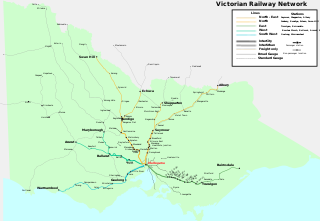
Rail transport in the Australian state of Victoria is provided by a number of railway operators who operate over the government-owned railway lines. The network consists of 2,357 km of Victorian broad gauge lines, and 1,912 km of standard gauge freight and interstate lines; the latter increasing with gauge conversion of the former. Historically, a few experimental 762 mm gauge lines were built, along with various private logging, mining and industrial railways. The rail network radiates from the state capital, Melbourne, with main interstate links to Sydney and to Adelaide, as well as major lines running to regional centres, upgraded as part of the Regional Fast Rail project.
The Gippsland V/Line rail service is a passenger service operated by V/Line in Victoria, Australia between Melbourne and the Gippsland region including the regional cities of Moe, Morwell, Traralgon, Sale and Bairnsdale. It operates along the Gippsland railway line.

The Regional Fast Rail project was a rail transport project undertaken by the State Government of Victoria, Australia, between 2000 and 2006 aimed at improving rail services on the Victorian regional railway network, specifically to reduce travel times, enhance service frequency and safety.

The Geelong line is a regional passenger rail service operated by V/Line in Victoria, Australia. It serves passengers between state capital Melbourne and the regional city of Geelong.
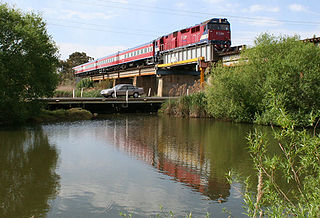
The Warrnambool line is a long-distance regional rail service in Victoria, Australia. Operated by V/Line, it is the state's fourth longest railway line at 267.3 kilometres (166.1 mi). The line runs from Southern Cross station in central Melbourne to Warrnambool station in the south-west, serving 21 stations via Wyndham Vale, Geelong, Waurn Ponds, and Colac. The line has five return services each weekday and three return services on weekends. Trains on the Warrnambool service run with three- to five-car N-class carriage sets, which are hauled by N class locomotives.

The V/Line VLocity, sometimes called the VLocity 160, is a diesel multiple unit train built by Bombardier Transportation and later Alstom in Dandenong for V/Line, the regional rail operator in the Australian state of Victoria. Continuously in production since 2003, the VLocity is the highest-speed train in the V/Line fleet, with a top speed of 160 km/h (99 mph). As of February 2024 with set 114 entering service, 112 3-car sets are in revenue service, 2 collision damaged sets are in storage, and 25 more are under construction on the current confirmed orders.

Donnybrook railway station is located on the North East line in Victoria, Australia. It serves the northern Melbourne suburb of Donnybrook, and it opened on 14 October 1872.

Seymour railway station is on the North East line in Victoria, Australia. It serves the town of Seymour, and opened on 20 November 1872. The station is the terminus for V/Line's Seymour line services.

Wangaratta railway station is located on the North East line in Victoria, Australia. It serves the town of the same name, and opened on 28 October 1873.

Springhurst railway station is located on the North East line in Victoria, Australia. It serves the town of the same name, and opened on 29 November 1873 as Springs. It was renamed Springhurst in October 1890.
The North East railway line is a railway line in Victoria, Australia. The line runs from Southern Cross railway station on the western edge of the Melbourne central business district to Albury railway station in the border settlement of Albury-Wodonga, serving the cities of Wangaratta and Seymour, and smaller towns in northeastern Victoria.
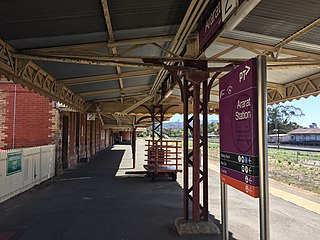
Ararat railway station is located on the Serviceton and Western standard gauge lines in Victoria, Australia. It serves the town of Ararat, and opened on 7 April 1875.
The Tocumwal railway line is a 1,600 mm gauge railway line in Victoria, Australia. The line runs between the border town of Tocumwal in New South Wales to Southern Cross, Melbourne. The line is utilised by various passenger and freight trains serving the northern suburbs of Melbourne and northern regions of Victoria.

Inland Rail is a 1600-kilometre (990 mi) railway line under construction in Australia. Once complete, it will connect the Melbourne and Brisbane along a new route inland through Victoria, New South Wales and Queensland that allows for the use of double-stacked freight trains.

The N Class are a class of diesel locomotives built by Clyde Engineering in Somerton for V/Line between 1985 and 1987.
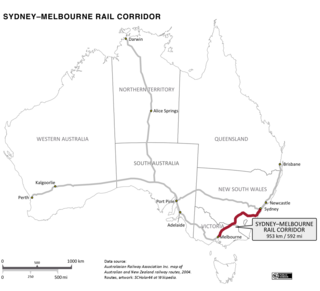
The Sydney–Melbourne rail corridor consists of the 953-kilometre (592-mile) long 1435 mm standard-gauge main line between the Australian state capitals of Sydney and Melbourne (Victoria) and the lines immediately connected to it. Freight and passenger services operate along the route, including the NSW TrainLink XPT passenger service.
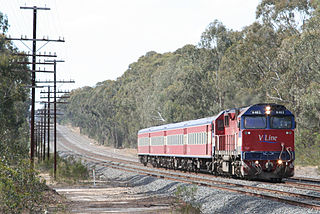
Hoys Roadlines was an Australian bus operator based in the Victorian city of Wangaratta. From 1993 until 2004 the company also had a contract to operate train services on the Shepparton line on behalf of the Victorian State Government.




















